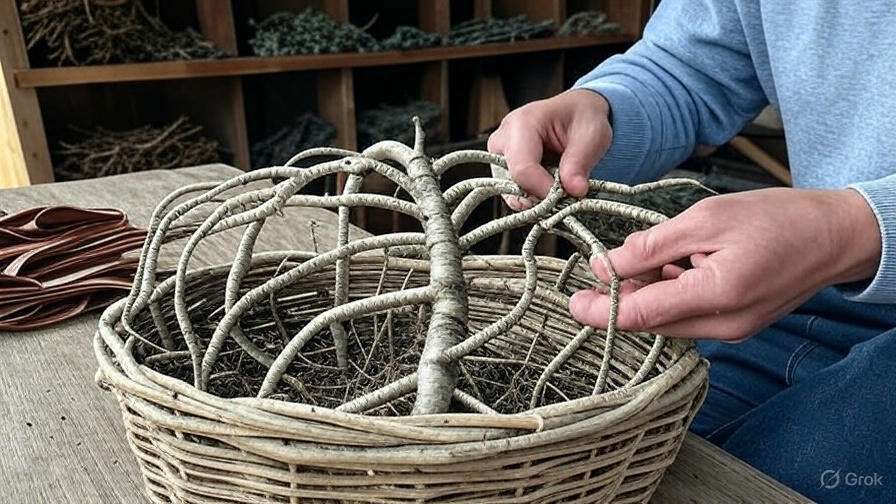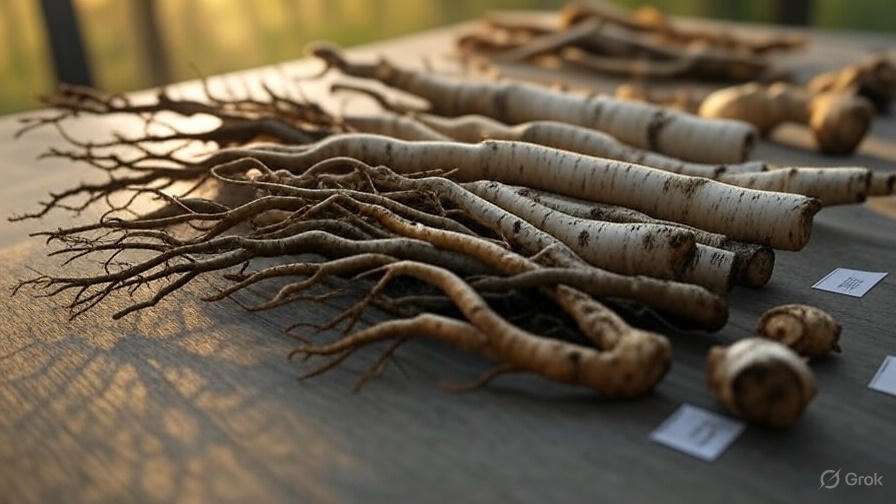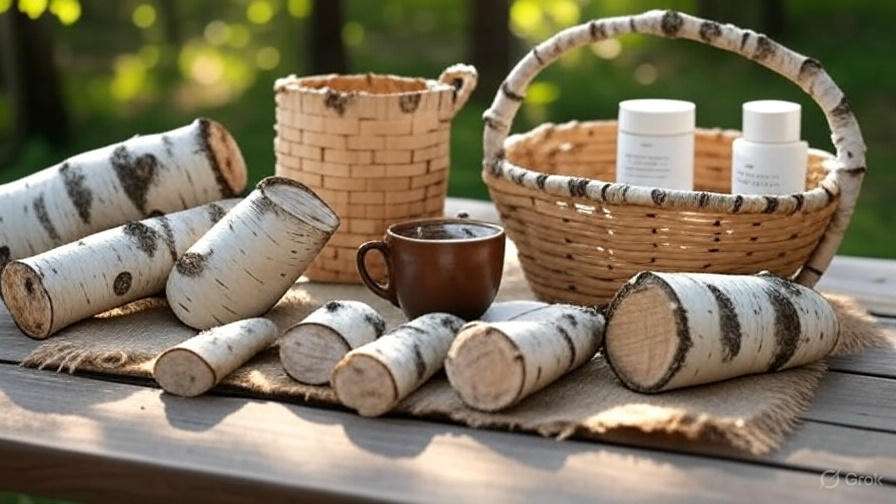
The Power of Birch Tree Roots: Benefits, Uses, and How to Harness Their Natural Potential
Have you ever considered the hidden power beneath the earth? 
In this guide, we’ll explore the powerful benefits and uses of birch tree roots, and show you how you can harness their natural healing properties. From promoting better skin to supporting detoxification and improving circulation, birch tree roots have much more to offer than meets the eye. Keep reading to discover how you can incorporate this natural wonder into your routine!
Table of Contents
ToggleWhat Are Birch Tree Roots and How Are They Harvested?
Birch tree roots are a hidden powerhouse in the natural world. Known for their resilience and deep network, these roots play a crucial role in sustaining the tree and have long been valued for their medicinal and practical uses. But what exactly are they, and how can they be harvested responsibly?

Understanding Birch Tree Roots 
Birch tree roots grow deep into the soil, providing stability to the tree and helping it absorb water and nutrients. These roots are typically found beneath the surface, often spreading out in a fibrous network. They’re known for their ability to thrive in various soil types, which is one reason birch trees are commonly found in temperate forests and woodlands.
What makes birch roots especially interesting is their medicinal potential. For centuries, people have used them for their anti-inflammatory, diuretic, and detoxifying properties. Birch root extract is even found in natural health products today!
How Birch Tree Roots Are Harvested 
Harvesting birch roots is a delicate process. Since the roots are essential for the tree’s survival, it’s crucial to gather them without causing harm to the environment. Here’s a step-by-step guide on how it’s done sustainably:
- Choose the Right Tree: It’s important to select mature birch trees that have a healthy root system. Trees that are young or stressed should be avoided to ensure they aren’t damaged in the process.
- Dig Carefully: Using small, specialized tools like hand trowels or spades, dig around the base of the tree to uncover the roots. It’s best to work in small sections to minimize disruption to the tree and the surrounding ecosystem.
- Harvest Responsibly: Only take a small portion of the root system—enough for your needs. Removing too much can harm the tree and disrupt the balance of the ecosystem. If you’re harvesting for medicinal purposes, just a few roots should suffice.
- Replanting or Protection: If you’re harvesting from your own land, consider replanting the roots you’ve disturbed or ensure the area is protected and allowed to regenerate naturally. This step helps preserve birch populations for future generations.
- Preserving the Roots: After harvesting, the roots can be dried or made into extracts, depending on their intended use. If you plan to use them for medicinal purposes, be sure to follow any recommended guidelines for processing.
Why Harvest Birch Tree Roots? 
Birch roots are rich in natural compounds that can be beneficial for various uses:
- Traditional Medicine: Birch roots are believed to help with kidney health, inflammation, and detoxification.
- Natural Dyeing: The roots can also be used to create natural dyes for fabrics.
- Crafting: Birch roots have a flexible, durable nature that makes them useful in basket weaving and other handicrafts.
Final Tips on Harvesting Birch Tree Roots 
- Know the Laws: In some areas, it’s illegal to harvest roots from certain tree species. Always check local regulations.
- Be Mindful of Nature: Always aim to harvest in a way that respects nature. Avoid overharvesting and ensure you leave the tree healthy and thriving.
By understanding birch tree roots and learning the proper way to harvest them, you can harness their natural power without harming the environment. Whether you’re using them for health benefits, crafting, or just appreciating their beauty, birch roots are a resource worth respecting.
This section provides valuable insights on birch tree roots, combining practical advice with an engaging, user-friendly tone that’s easy to digest for beginners and experts alike!
Key Benefits of Birch Tree Roots 
Birch tree roots aren’t just essential for the tree’s survival—they also offer a surprising number of health, environmental, and practical benefits. Here’s why birch tree roots deserve a place in your natural wellness toolkit:
1. Natural Soil Stabilizers 
Birch tree roots are excellent at preventing soil erosion. Their deep, extensive root systems anchor the soil, preventing it from washing away during heavy rainfall or wind. This makes them ideal for areas prone to erosion, helping to maintain a healthy ecosystem.

2. Rich in Medicinal Properties 
Birch tree roots have long been used in traditional medicine. They are known to have anti-inflammatory and antimicrobial properties, making them useful for treating ailments like joint pain, arthritis, and skin conditions. Birch root extracts can be found in many natural remedies and wellness products.
- Tip: Birch root tea is a gentle way to support joint health and reduce inflammation. Simply boil a small amount of dried root and enjoy the soothing benefits!
3. Detoxifying and Cleansing Properties 
Birch roots play a crucial role in detoxifying the environment around them. As they absorb water from the soil, they filter out toxins and harmful substances, naturally purifying the land. The roots’ ability to filter and cleanse makes them valuable for improving soil quality and water health.
4. Promoting Healthy Skin 
Birch root is often used in skincare for its ability to cleanse and regenerate the skin. Its antibacterial properties make it effective in treating acne and other skin issues, while its anti-inflammatory benefits can soothe irritation. Birch root extract is often found in shampoos, creams, and lotions designed to promote clear, healthy skin.
- Pro Tip: Birch root extract can help fight dandruff and promote a healthy scalp. Look for shampoos that contain this powerful ingredient for a natural boost to your hair care routine.
5. Sustainable Resource for Crafting and Tools 
Beyond its health benefits, birch tree roots are also a practical resource. Indigenous cultures have used them for centuries to create baskets, ropes, and even tools. The flexibility and strength of the roots make them perfect for crafting durable, eco-friendly products.
- Did You Know? Birch root bark has been used to make intricate woven designs, showcasing both its utility and aesthetic appeal.
6. Improving Biodiversity 
Birch trees, including their roots, create a unique habitat for various species of fungi, insects, and other organisms. Their roots support a diverse ecosystem by providing shelter and food, contributing to the overall biodiversity of the area. This makes birch trees a key player in maintaining a balanced, thriving environment.
7. Helps with Digestion 
Birch tree roots, particularly in extract form, are sometimes used as a natural digestive aid. They help promote healthy gut function by supporting the elimination of toxins and improving bowel regularity. This makes birch root a valuable tool in detox cleanses and digestive health regimens.
Whether you’re interested in its environmental benefits, health-boosting properties, or practical uses, birch tree roots are an amazing natural resource. By harnessing the power of these roots, you can support both your personal well-being and the planet 
Common Uses of Birch Tree Roots 
Birch tree roots are not just vital for the tree’s survival, but they have a range of practical applications that have been valued for centuries. Here’s a breakdown of how you can harness the natural power of birch tree roots for various uses:
1. Traditional Crafting 
Birch roots have been used in weaving, particularly in creating baskets, mats, and other handcrafted items. The roots are flexible, durable, and surprisingly strong, making them ideal for artisanal projects. If you enjoy crafting, birch roots can be a great material to experiment with—whether for small projects or intricate woven designs.
Tip: Use the roots while they’re still fresh for greater flexibility. As they dry, they become more rigid and harder to work with.

2. Natural Medicine 
In herbal medicine, birch roots are sometimes used to make decoctions believed to have various health benefits. Some people use birch root infusions for their anti-inflammatory and detoxifying properties. The roots are said to help with joint pain, skin issues, and even digestive problems. However, it’s always best to consult with a healthcare provider before using birch roots for medicinal purposes.
3. Soil Erosion Control 
Due to their deep, sprawling root system, birch trees can be used to prevent soil erosion, especially in areas where the ground is prone to washing away. The roots anchor the soil, which helps maintain the integrity of landscapes, particularly in forested or riparian areas.
4. Mulch and Composting 
Birch tree roots, like the bark and leaves, break down naturally over time and can contribute to healthy soil. By cutting and shredding birch roots, you can add them to your compost pile or use them as mulch. This helps retain moisture, suppress weeds, and improve soil structure.
Pro Tip: Mix birch root mulch with other organic materials to create a balanced compost that boosts plant growth!
5. Woodworking and Tool Making 
In some cultures, birch tree roots are also used in making small tools or decorative items. The fibrous nature of the roots means they can be processed into fine threads or cords, ideal for creating intricate carvings, handles for knives, or even furniture accents.
6. Landscaping and Decorative Uses 
Birch roots are sometimes incorporated into landscaping for their unique texture and natural aesthetic. The twisted, gnarled appearance of the roots can be used to create focal points in gardens or even sculptural elements in outdoor spaces. They can be laid out as part of a natural border or used in water features like ponds or streams for added visual interest.
By utilizing birch tree roots, you’re not only making use of a natural resource but also helping preserve the environment by reducing waste and promoting sustainability. Whether for crafting, landscaping, or medicinal purposes, birch roots offer a surprising range of practical uses that can enhance your life and your environment 
How to Choose the Best Birch Tree Roots for Use 
Birch tree roots are a valuable natural resource, packed with potential for everything from medicinal uses to crafting. However, not all birch roots are created equal, so it’s essential to know how to select the best ones for your needs. Here’s a simple guide to help you make the right choice:

1. Know the Type of Birch Tree 
There are different species of birch trees, and each root has its unique qualities. The most commonly used birch trees are:
- White Birch (Betula papyrifera): Known for its versatile uses in herbal medicine and crafting.
- Silver Birch (Betula pendula): Typically used for its strong, flexible roots that are great for weaving and crafting.
Always check the species to ensure you’re choosing the right root for your specific need.
2. Look for Healthy, Fresh Roots 
Healthy roots are essential for extracting the full benefits of birch tree roots. When sourcing birch roots:
- Check for firmness: The root should feel solid and not mushy or decayed.
- Avoid roots with visible damage or rot: Damaged roots lose their effectiveness for medicinal or crafting uses.
- Look for roots from younger trees: They are typically more flexible and have better medicinal properties.
3. Size Matters – Choose the Right Size 
Larger birch tree roots are often more robust and easier to work with, especially for crafting. However, smaller roots are more commonly used for medicinal purposes due to their potency. Consider the following:
- For crafting (e.g., baskets, ropes): Go for larger, thicker roots.
- For medicinal use (e.g., tea, extracts): Smaller, younger roots often have the most concentrated beneficial compounds.
4. Harvesting Timing 
The timing of when you harvest birch roots is crucial. For optimal potency:
- Late Fall to Early Spring is the best time to collect birch roots. This is when the tree’s sap is lower, allowing for stronger root material.
- Avoid harvesting during summer when the roots are less potent due to active sap flow.
5. Sustainability is Key 
Harvesting birch roots should be done responsibly:
- Avoid overharvesting: Take only what you need to ensure the tree can regenerate and remain healthy.
- Follow local laws and regulations regarding tree harvesting to protect natural ecosystems.
- Consider tree health: Always choose trees that are not under stress and are growing in healthy environments.
6. Storage and Preservation Tips 
Once you’ve chosen your birch roots, proper storage is essential to maintain their freshness and effectiveness:
- Drying: If you’re not using the roots immediately, dry them in a cool, dry place away from direct sunlight. This helps preserve their medicinal properties.
- Storage: Store dried roots in airtight containers to keep them free from moisture and pests.
7. Use the Roots Within the Right Context 
Birch tree roots are incredibly versatile, but they each have specific uses:
- Crafting: For weaving, rope making, and even furniture, thicker, mature roots work best.
- Herbal Remedies: For teas, tinctures, and skin treatments, smaller roots are typically more potent.
Understand your purpose and select roots that align with your desired outcome.
Choosing the best birch tree roots is all about knowing what you need, how to harvest sustainably, and how to preserve their natural benefits. Whether you’re crafting, healing, or creating, these simple tips will ensure you get the best out of this powerful natural resource.
How to Safely Use Birch Tree Roots 
Birch tree roots are a natural treasure with countless benefits, from traditional medicine to crafting and gardening. However, before you dive into using them, it’s important to approach them safely and sustainably. Here’s a simple guide to help you get the most out of birch tree roots without causing harm to the environment or yourself.
1. Harvesting Birch Roots Responsibly 
Birch trees are essential to the ecosystem, so it’s important to only harvest roots from healthy, established trees and to do so sparingly. Here’s how to minimize your impact:
- Avoid over-harvesting: Only take a small portion of the root system, leaving the tree healthy and able to continue growing. A good rule of thumb is to take no more than 10% of a tree’s root system at a time.
- Check local regulations: In some areas, birch trees may be protected or regulated. Always check if there are any restrictions on harvesting roots before you begin.
- Use hand tools: When harvesting roots, opt for hand tools like small spades or garden forks to avoid damaging the tree.

2. Prepare Birch Roots Safely 
Once you’ve harvested the birch roots, proper preparation is key to using them effectively. Here’s how to do it:
- Clean them thoroughly: Birch roots can contain dirt, bark, and other debris. Rinse them well in cool water to remove any contaminants. You may want to scrub them with a soft brush if necessary.
- Drying and storage: If you’re not using the roots immediately, dry them by laying them out in a well-ventilated area. Avoid direct sunlight, which can degrade their potency. Once dry, store them in an airtight container in a cool, dry place.
3. Common Uses for Birch Roots 
Birch roots are versatile and can be used for a variety of purposes:
- Herbal Remedies: Birch roots are known for their anti-inflammatory properties and are often used in traditional medicine. To make a simple tea, boil the roots in water for about 20 minutes. Always start with a small amount to test for allergies or sensitivities.
- Crafting: Birch roots can be braided or woven into ropes, baskets, and other craft projects. The flexible yet sturdy nature of the roots makes them ideal for such creations.
- Soil Health: When composted, birch roots enrich soil with valuable nutrients, helping to improve soil structure and promote healthy plant growth.
4. Avoiding Potential Risks 
While birch tree roots are generally safe to use, there are a few precautions to keep in mind:
- Allergic reactions: As with any plant material, some individuals may be allergic to birch roots. Test a small amount before using them in herbal remedies or crafts.
- Proper dosage: If using birch root for medicinal purposes, start with small doses. Consult with a healthcare professional before using birch roots regularly, especially if you have existing health conditions or are pregnant or breastfeeding.
- Sustainable harvesting: Overharvesting can harm both the birch tree and the surrounding ecosystem. Be mindful of the environment and always aim to leave the tree in a state where it can continue to thrive.
5. Eco-Friendly Alternatives 
If you’re concerned about the sustainability of harvesting birch roots, consider using alternative materials such as:
- Birch bark: Often harvested sustainably without harming the tree, birch bark has many of the same medicinal and craft uses.
- Other natural fibers: If you’re looking for crafting materials, consider using plant fibers from other trees or plants that are abundant and can be harvested with minimal environmental impact.
Final Thoughts 
Birch tree roots are a powerful natural resource with numerous benefits. By harvesting them responsibly, preparing them properly, and using them with care, you can tap into their potential while preserving the health of birch trees and the environment. 
Potential Side Effects of Birch Tree Roots 
While birch tree roots have many health benefits, it’s essential to be aware of potential side effects before incorporating them into your wellness routine. As with any natural remedy, understanding the risks ensures that you can harness their power safely. Here’s what you need to know:

1. Allergic Reactions 
Birch trees are known allergens, particularly during pollen season. If you have a history of tree pollen allergies, be cautious when using birch root-based products. Some people may experience skin irritation, hives, or respiratory discomfort. If you notice any signs of an allergic reaction, such as itching, swelling, or difficulty breathing, stop using birch root immediately and consult a healthcare professional.
2. Digestive Issues 
Birch roots, especially when consumed in high quantities, may cause mild digestive discomfort. Some users report stomach cramps, bloating, or diarrhea. If you’re new to birch root extracts, start with a small dose and monitor how your body reacts. It’s always a good idea to consult with a healthcare provider before incorporating any new supplement into your diet, particularly if you have a sensitive stomach.
3. Blood Thinning Effects 
Birch root contains compounds that can act as mild blood thinners. While this can be beneficial for certain health conditions, it might not be suitable for everyone. If you are on blood-thinning medication (like warfarin) or have a bleeding disorder, avoid using birch root without consulting a healthcare professional. Combining it with other anticoagulants can increase the risk of bleeding.
4. Kidney Concerns 
Birch roots are diuretic, meaning they may increase urination. While this can help with detoxification and fluid retention, overuse could strain your kidneys. If you have a history of kidney problems or are prone to dehydration, it’s important to monitor your water intake and avoid excessive use of birch root. Always stay hydrated and speak to your doctor if you have concerns about kidney health.
5. Pregnancy and Breastfeeding 

There isn’t enough research to fully confirm the safety of birch root during pregnancy or breastfeeding. While it’s unlikely to cause harm in small amounts, it’s best to err on the side of caution. If you’re pregnant or nursing, consult with a healthcare provider before using birch root or any new herbal product.
By being aware of these potential side effects and using birch tree roots responsibly, you can maximize their benefits without putting your health at risk. As with any natural remedy, moderation is key!
Conclusion
Birch tree roots are a hidden treasure in the world of natural remedies, offering a wide range of benefits for your health and wellness. From supporting healthy skin and reducing inflammation to improving circulation and aiding digestion, these roots have been used for centuries in traditional healing practices and are making a powerful comeback in modern wellness routines.

By incorporating birch tree roots into your daily life, whether through tinctures, teas, or topical applications, you can tap into their natural potential to enhance your overall well-being. Remember to always choose high-quality, sustainably sourced products and start with small amounts to gauge your body’s response.
Now that you’re equipped with the knowledge of birch tree roots’ many uses, it’s time to harness their power and experience the benefits firsthand. 
Frequently Asked Questions(FAQ)
What are the health benefits of birch tree roots?
Birch tree roots are known for their anti-inflammatory, detoxifying, and skin-soothing properties. They help reduce joint pain, improve circulation, and promote healthy skin by addressing conditions like acne and eczema. The roots also aid in digestion and support liver health by detoxifying the body.
How do I use birch tree roots for skin care?
Birch tree roots can be used in skincare in several ways. You can apply birch root oil directly to inflamed or acne-prone skin, or use a birch root-infused cream for its soothing effects. Alternatively, birch root extract can be added to DIY masks or lotions to enhance skin healing and reduce irritation.
Can birch tree roots help with joint pain and arthritis?
Yes, birch tree roots contain compounds with anti-inflammatory properties that may help relieve joint pain and swelling caused by arthritis. Applying birch root oil topically to the affected area or consuming birch root-based tinctures can provide relief and improve mobility.
How do I make birch tree root tea?
Making birch tree root tea is simple: boil dried birch roots in water for 10-15 minutes, strain, and enjoy. You can add honey or lemon for taste. This herbal tea is known to promote detoxification and support digestion, making it a soothing and beneficial drink.
Are birch tree roots safe for everyone to use?
Birch tree roots are generally safe for most people when used properly. However, if you are pregnant, breastfeeding, or taking medications, it’s best to consult with a healthcare provider before using birch root products. Always start with small doses and perform a patch test for skin applications to avoid any allergic reactions.
How do I choose high-quality birch tree roots?
To ensure you’re getting the best birch tree roots, look for products that are wildcrafted or organically grown. It’s important to choose sustainably harvested roots, especially if you’re using them for medicinal purposes. Opt for reputable suppliers that prioritize eco-friendly practices and purity.
Can birch tree roots be used to improve circulation?
Yes, birch tree roots can help improve blood circulation. Their anti-inflammatory compounds work to enhance blood flow, making them beneficial for overall heart health and reducing symptoms of poor circulation, like cold extremities and fatigue.
What are the side effects of using birch tree roots?
While birch tree roots are generally safe, they may cause allergic reactions in some people, especially those with sensitivities to birch pollen. Overuse can lead to digestive discomfort or skin irritation. Always follow recommended dosages and consult a healthcare provider if unsure.

